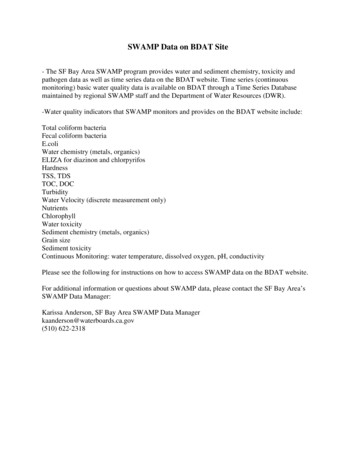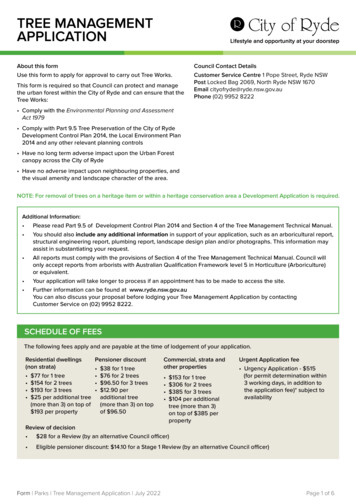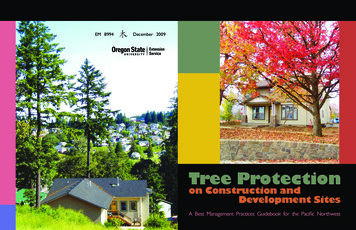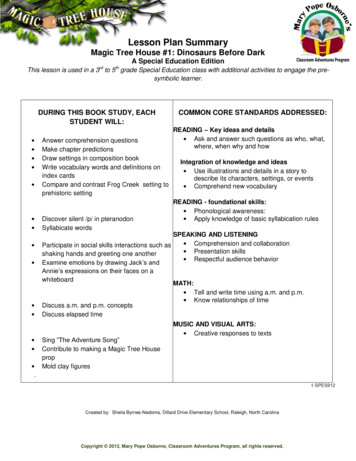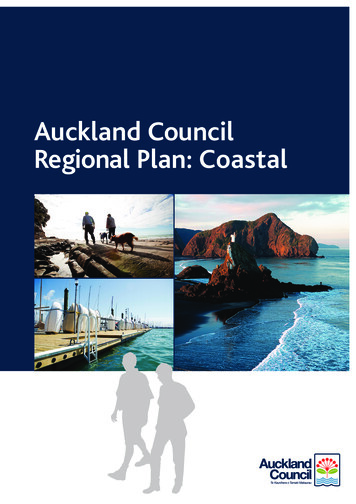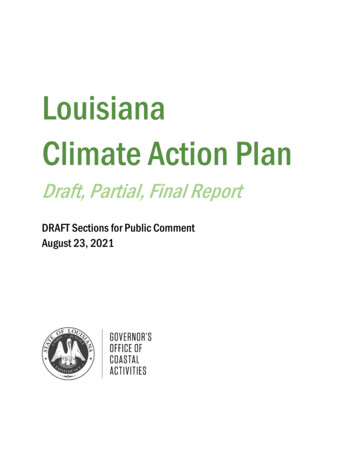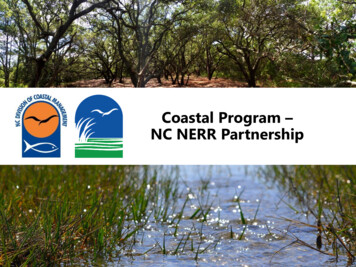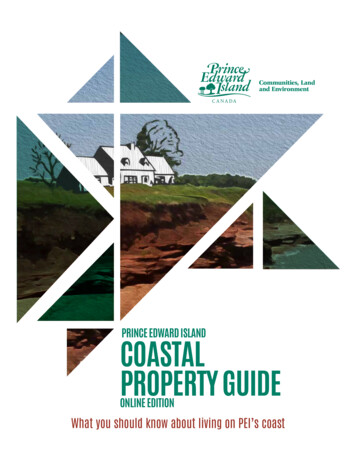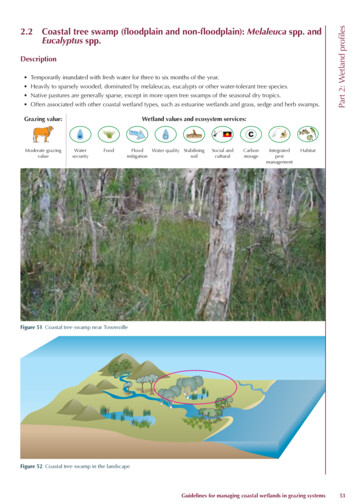
Transcription
Description Temporarily inundated with fresh water for three to six months of the year.Heavily to sparsely wooded, dominated by melaleucas, eucalypts or other water-tolerant tree species.Native pastures are generally sparse, except in more open tree swamps of the seasonal dry tropics.Often associated with other coastal wetland types, such as estuarine wetlands and grass, sedge and herb swamps.Grazing value:Part 2: Wetland profiles2.2 Coastal tree swamp (floodplain and non-floodplain): Melaleuca spp. andEucalyptus spp.Wetland values and ecosystem services:CModerate grazingvalueWatersecurityFoodFloodWater quality StabilisingmitigationsoilSocial bitatFigure 51 Coastal tree swamp near TownsvilleFigure 52 Coastal tree swamp in the landscapeGuidelines for managing coastal wetlands in grazing systems53
Part 2: Wetland profilesLandformDepressions on flat, broad floodplains, in the swales between coastal dunes, in theback levees of stream channels or on the inland side of saline wetlands.Vegetation descriptionThese wetlands are dominated by tea-trees Melaleuca spp. with an understorey ofgrasses, sedges, ferns, herbs and aquatic plants.Native pasturesIschaemum spp., swamp rice grass, blady grass, black and giant speargrass,saltwater/marine couch and kangaroo grass.Suitable sown pasturesIt is not recommended that pasture species be sown in these wetlands.Exotic pasture grassesand weedsOlive hymenachne, paragrass, aleman grass, pond apple, groundsel bush,rubbervine, lantana, papyrus, devil’s fig and water hyacinth.SoilA broad range of soil types depending on the position in the landscape, from siltyto loamy clays, siliceous sands to poorly oxygenated marine clays. Soil originallyfrom estuarine, stream or floodplain deposits. Main soil types include hydrosols,vertosols, sodosols, organosols and chromosols.Surface soils are hard-setting and underlying soil may be Potential Acid Sulfate Soil(PASS) as peat, sand or mud.Land use and management recommendationsManaging stock accessand grazingWell managed grazing over the dry season, through light stocking rates, lighterstock (e.g. weaners) and/or rotational or flexible grazing can provide productionbenefits whilst maintaining biodiversity.Wet season spelling and flexible/rotational grazing regimes provides a respite fromgrazing and disturbance, allowing wetland plants to set seed and germinate and foryoung plants to grow. Spelling also provides opportunities for frogs, birds and otherwildlife to breed.Dec Jan FeugMar Apr MayovbIndicative grazing seasonality diagram(green managed grazing, red spelling,amber limited grazing). This may varydepending on wetland condition, climateand key management objectives*:Sep Oct NGrazing regimes should be determined based on the management objectives,condition, weed threat and water flows in the wetland.JunJulA* For example, if the management objective is to control exotic pasture grasses in seasonallydry climates, light stocking over the wet season could be appropriate).54Grazing for Healthy Coastal Wetlands
Road crossings, floodgates, levee-banks, ponded pastures and dams can modifywater regimes, as can draining wetlands for development. This impacts vegetationcommunities and the wildlife that these wetlands can support. Changes in waterflow can also seriously impact fish movement within and between wetlands.Ponded pastures, levees and bunds must not be constructed in or adjacent tocoastal tree swamps.Coastal tree swamps are fairly tolerant to nutrient loads, but overloading thewetland will eventually lead to dieback of wetland trees and invasion by weeds.Cattle camps should be located away from these wetlands to reduce nutrient inputfrom stock urine and faeces.Managing firePart 2: Wetland profilesManaging waterIn their natural state, coastal tree swamps are relatively fire tolerant due to the highmoisture levels and low fuel loads supporting low intensity, mosaic burns. Fire alsohas a role in encouraging the recruitment of Melaleuca spp. These wetlands can actas natural firebreaks and a refuge for animals during fire in adjacent terrestrial areas.To maintain the integrity of coastal tree swamps burns should only be: low to moderate intensity patchy or mosaic, creating a mosaic of burnt and unburnt areas carried out when the wetland soil is saturated carried out at intervals at which fire would have naturally occurred or beenused by Traditional Owners (e.g. recommendations vary from 15-30 years forfire sensitive wetlands to 3-8 years for more open wetlands in seasonally dryclimatic regions).Figure 53 Ungrazed exotic pasture grasses can create large fuel loads which pose a risk ofintense fires in seasonally dry climatesToo frequent fires can result in a net loss of nutrients from the system.Different burn regimes may be required to meet specific management objectives,such as weed control.Guidelines for managing coastal wetlands in grazing systems55
Part 2: Wetland profilesManaging weedsExotic pasture grasses and weeds can dominate the understorey causing majorchanges to the vegetation community and wetland ecosystem services by: outcompeting and excluding native grasses and sedges, important for nativeanimals smothering the water surface and degrading water quality and habitat for fishand other aquatic animals increasing fuel loads leading to frequent, intense fires that kill wetland trees andalter the vegetation composition to a grass dominated open-forest (particularlyin seasonally dry climates).Weeds are spread by animals, water and vehicles and will often dominate areas thathave been disturbed by machinery, frequent fires or overgrazing. For example, thepresence of Devil’s fig can be a sign of heavy grazing pressure.In wetlands invaded by exotic pasture grasses, the exclusion of stock can allowexotic pasture grasses to smother the wetland leading to the loss of wetlandecosystem services and values. Grazing can help reduce the dominance of exoticpasture grasses and maintain wetland values.Figure 54 Dry season grazing is keeping olive hymenachne cropped in this wetland nearMackay.In the seasonal dry tropics trials have shown that light grazing throughout thewet season (to prevent exotic pasture dominance over the growing season) andmoderate grazing pressure at the end of the dry season (to crop down exoticpastures) can be an effective grazing regime for controlling the dominance of exoticpasture grasses.An integrated program of controlled grazing, carefully planned and managedburns and natural water level fluctuations can help control weeds and exoticpasture grasses. Refer to www.deedi.qld.gov.au or your local government weedmanagement officer for more information and guidance.Managing animal pestsFeral pigs can cause extensive damage to coastal tree swamps, by fouling andmuddying the water, digging up plants, destabilising banks and destroying the nestsof native animals.Pig control programs are recommended to reduce numbers, refer to www.deedi.qld.gov.au for advice.56Grazing for Healthy Coastal Wetlands
Part 2: Wetland profilesFigure 55 Pigs have caused sediment disturbance and destroyed native plants in thiswetland in Lakefield National Park. Source: DERMOther land use limitationsRegulations and approvals may apply to works or activities in and around thesewetlands, such as: removing or disturbing vegetation earthworks (filling or excavation) construction of infrastructure such as levees, causeways, weirs, roads, culvertsor works that alter water flows (drainage works or water storages) taking or interfering with water disturbance of or tampering with animal breeding places, such as nests orhollows, where protected wildlife breed or raise their young works within protected areas, such as declared Fish Habitat Areas, Ramsarlisted wetlands and declared Wild Rivers areas.Figure 56 Tree swamps are often associated with grass, sedge and herb swampsThere may be other requirements for grazing enterprises, such as maintainingground cover and land condition and managing weeds and pests. Refer to theLegislation Toolbox for information ml).Coastal tree swamps are key contributors to primary production which is thenexported to adjacent tidal habitats. The association with other wetland types meansthat the management of coastal tree swamps should be undertaken in conjunctionwith adjacent wetlands.Guidelines for managing coastal wetlands in grazing systems57
Part 2: Wetland profilesUnderlying soils are often PASS. When excavated or drained PASS reacts with air toproduce sulphuric acid, which can cause significant environmental and economicimpacts.Crocodiles may be a safety consideration for humans and stock in central and northQueensland.Conservation featuresMany vulnerable and endangered plants occur in coastal tree swamps, includingspecies of orchid, wattle and grevillea.Melaleuca spp. trees provide an important source of nectar and pollen for insects,birds and bats and are used for nesting and roosting. Frogs are common in theunderstorey vegetation and fish use these wetlands when they are seasonallyinundated.Relevant land typesTea-tree flats (CB12), Coastal teatree plains (FT10), Coastal tea-tree plains (MW04),Sandy forest (NG13), Coastal country (SG03).Regional EcosystemsThere are 29 Regional Ecosystems (RE’s) that contain coastal tree swamps: Gulf plains: 2.3.28 11 Cape York Peninsula: 3.2.3*, 3.2.4*, 3.2.14*, 3.3.12* Wet tropics: 7.2.8*, 7.2.9*, 7.3.5*, 7.3.34* Central Queensland coast: 8.1.5*, 8.2.4*, 8.2.7a,b&e*, 8.2.11*, 8.2.13b*,8.3.11*, 8.3.13a&b*, 8.5.2*, 8.5.6* Brigalow belt: 11.3.12 Southeast Queensland: 12.1.1*, 12.2.5a, 12.2.7, 12.3.4*, 12.3.5, 12.3.6, 12.5.4* Classified as ‘of concern’ or ‘endangered’Further informationand referencesFor information on the use of late dry season grazing and fire to manage exoticpasture grasses in the seasonal dry tropics see: Tait, J. (2010) Guidelines for the use of grazing for management of exoticpasture weeds in wetland and riparian habitats. WetlandCare Australia, NSW Adams, E. Tedlands Station Wetlands Project – Grazing and Fire RegimeManagement. Information Bulletin No. 1 for the GBR Coastal WetlandProtection Program. Mackay Whitsunday NRM Group. Bloor, M. and Tait, J. Tedlands Station Wetlands. Mackay Whitsunday NRMGroup. Australia. Department of Environment and Resource Management (2009) RegionalEcosystems. Viewed 4 November 2010. ty/regional ecosystems/index) Department of Primary Industries and Fisheries (2009) Land types ofQueensland. State of Queensland (Department of Primary Industries andFisheries), Brisbane. Joyce, K. (2006) Wetland Management Profile – Coastal Melaleuca SwampWetlands. Queensland Wetlands Program, Brisbane.58Grazing for Healthy Coastal Wetlands
Scientific nameCommon NameGrassesChrysopogon fallaxGolden beard grassHeteropogon spp.SpeargrassImperata cylindricaBlady grassPart 2: Wetland profilesPlant species commonly found in coastal tree swamps (floodplain and non-floodplain):Melaleuca spp. and Eucalyptus spp.Ischaemum spp.Leersia hexandraSwamp rice grassPhragmites australisCommon reedSporobolus virginicusSaltwater/marine couchThemeda triandraKangaroo grassSedges and RushesBaumea articulataJointed twigrushBaumea rubiginosaSoft twigrushCyperus difformisDirty dora/ rice sedgeCyperus trinervisSedgeCyperus spp.SedgeDapsilanthus ramosusSaw-SedgeGahnia sieberianaSaw-SedgeIsolepis nodosaKnobby club rushLepironia articulataSchoenus brevifoliusBogrushBroadleaf herbs and shrubsAcrostichum speciosumMangrove fernBlechnum spp.FernsBoronia spp.BoroniaCrinum pedunculatumMangrove lilyDurringtonia paludosaDurringtoniaBroadleaf herbs and shrubs (continued)Lycopodiella serpentinaBog clubmossLygodium microphyllumClimbing maidenhairPhaius spp.Swamp orchidSprengelia sprengelioidesSprengeliaStenochlaena palustrisClimbing swamp fernTreesAcacia spp.WattleCasuarina spp.She-oakCorymbia spp.BloodwoodEucalyptus spp.Gum treeExcoecaria parvifoliaGutta-perchaGrevillea spp.GrevilleaGuidelines for managing coastal wetlands in grazing systems59
Part 2: Wetland profilesScientific nameCommon NameTrees (continued)Livistona spp.Cabbage tree palmLophostemon spp.Swamp boxMelaleuca spp.Paperbark or tea-treePandanus spp.Screw pineXanthorrhoea spp.Grass treeWaterlillies and other aquatic plantsNymphaea spp.WaterlilliesIntroduced species and weeds60Annona glabraPond appleBaccharis halimifoliaGroundsel BushBrachiaria muticaParagrassCryptostegia grandifloraRubber vineCyperus papyrusPapyrusEchinochloa polystachyaAleman grassEichhornia crassipesWater hyacinthHymenachne amplexicaulisOlive hymenachneLantana camaraLantanaSolanum torvumDevil’s figGrazing for Healthy Coastal Wetlands
Landform Depressions on flat, broad floodplains, in the swales between coastal dunes, in the back levees of stream channels or on the inland side of saline wetlands. Vegetation description These wetlands are dominated by tea-trees Melaleuca spp. with an understorey of grasses, sedges, ferns, herbs and aquatic plants.
